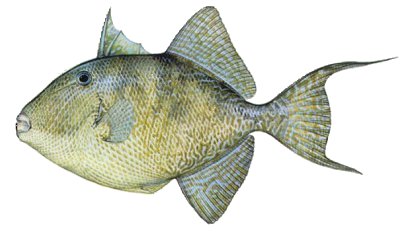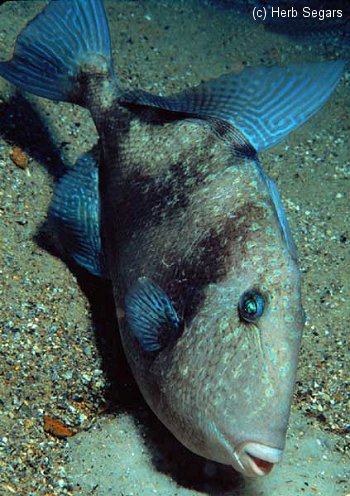Gray Triggerfish

Balistes capriscus
A Profile
by Stacey Reap
Range:
The Gray Triggerfish is found on both the eastern and western Atlantic coasts. Along the Atlantic coast of North America, it ranges from Nova Scotia and Bermuda to Argentina, including a presence in the Gulf of Mexico and the Caribbean Sea. Most of the approximately 40 other species in the Balistes family can be found in tropical seas worldwide.
Size:
Typically ranging between 12 to 16 inches in length, the Gray Triggerfish can reach lengths of nearly 20 inches. The world record catch of the species was a 13 lb. 9 oz. fish caught in Murrells Inlet, S.C., in 1989. The maximum age for gray triggerfish lies in the vicinity of 13 years, although they cannot be aged like most fish by counting the lines on their otoliths ( ear bones. ) Instead, a method of aging triggerfish has been developed using sections of the dorsal spine, but the accuracy of this technique needs to be verified.
Food and Feeding:
Gray triggerfish dine on bottom-dwelling invertebrates, such as crabs, shrimp, sea urchins, sand dollars, and mollusks. With large, strong, canine-like teeth arranged in a beak-like formation in their small mouths, Gray Triggerfish can dislodge and crush its often hard-shelled prey.
They have been observed employing a unique strategy when feeding on sand dollars and sea urchins. Orienting themselves perpendicular to and a few inches above the seafloor, the fish direct a stream of water at the surface to reveal sand dollars hidden beneath. After finding its victim, the fish grabs it in its front teeth, raises it approximately 6 feet above the bottom, and drops it. The process is repeated until the sand dollar lands upside down, at which point, the triggerfish once again assumes a vertical position above it. With its jaws shut, the fish then thrusts itself down onto the sand dollar, crushing its center. The result is a soft, tasty treat found inside.

Habitat:
Adult Gray Triggerfish are commonly found in depths up to 65 feet, associated with natural and artificial reef environments, as well as sand or grass flats and rocky bottom. The fish's first dorsal fin is comprised of three stiff spines, which can be locked in an upright position. When seeking protection, triggerfish can wedge themselves in reef nooks and crannies by locking their dorsal spines and erecting their pelvic bones. For those wishing to "disarm" the fish, the second dorsal spine or "trigger" acts as the release mechanism for the locked fin, and when pushed, permits all three spines to lay down along the fish's back.
After young fish hatch, they travel to the water's surface where they often make their home in mats of sargassum, a floating seaweed that hosts a variety of species. Juvenile fish, at 5 to 7 inches, leave the sargassum habitat and move to the reef habitat at the bottom of the ocean.
Spawning:
Gray Triggerfish spawn from July through September, after water temperatures reach 70°F. Females lay their eggs, which have an incubation period of two days, in hollow nests scooped out of the sandy bottom, and the male fish aggressively guard the nests.
Recreational and Commercial Importance:
This species used to have no attraction for recreational and commercial fishermen, but that is beginning to change. Long considered a bait-stealing pest by many fishermen targeting other reef species, the gray triggerfish is now becoming an intentional target as people discover their value as an excellent eating fish. As close relatives to filefishes, their rough, leathery skin also makes them a bit tricky to fillet, but their mild white meat is incentive enough to learn the proper method.
Gray Triggerfish can put up a great fight with their flat, round shape and care must be taken once they are on board to avoid their sharp spines and strong teeth. A small ( 1/0- 2/0 ) very sharp hook, baited with squid, is recommended to nab this unusual-looking fish's small, bony mouth.

This article first appeared in New Jersey Reef News - 2003 Edition


